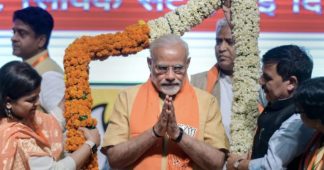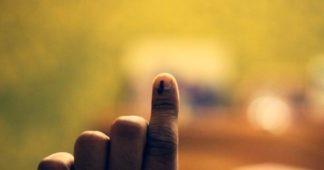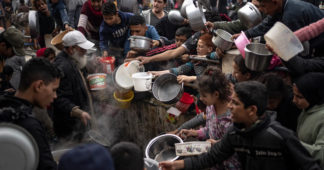Treating welfare programmes in a framework of people’s rights is, on the face of it, inconsistent with the basic tenets of neoliberalism.
By Manoranjan Mohanty
Jun 18, 2024
One of the crucial messages of the 2024 general elections is the defeat of the patrimonial approach of the governments which doled out numerous welfare programmes as their gifts and sought votes for it. Rather than treating them as necessary measures to alleviate people’s distress in a specific condition, the entire set of such programmes either named as prime minister’s or chief minister’s programme or after some other leader, was paraded as being given to ‘beneficiaries’ or Labharthees instead of citizens who actually had rights to such fundamental necessities for sustenance as Haqdars (rights-bearers). These rights were secured after long struggles and then acknowledged as such in course of legislations or the Supreme Court’s expanded interpretation of the ‘right to life’ under Article 21 of the Constitution.
Large-scale losses by the Bharatiya Janata Party (BJP) in Uttar Pradesh despite the many ‘welfare’ schemes by the double-engine Sarkar of Prime Minister Narendra Modi and chief minister Adityanath, the rout of Jagan Mohan Reddy’s Yuvajana Sramika Rythu Congress Party (YSRCP) in Andhra Pradesh and the defeat of Naveen Patnaik’s Biju Janata Dal (BJD) in Odisha are some of the stark examples. But ruling parties in West Bengal and Tamil Nadu, also famous for many welfare schemes, stood their ground with success.
Throughout the long-winding campaign, evocative speeches and prominent newspaper ads and more strikingly appealing video clips of various kinds of ‘labharthees’ expressing their gratitude to ‘the leader’ on primetime television created an overwhelming milieu of the ‘labharthee’ world. But the voters, now exposed to multiple sources of ideas and arguments from a range of political parties and social movements asserted their rights as citizens discerningly responding to a variety of issues including the welfare programmes. The message was loud and clear: treat us as citizens with rights and not objects of charity; after all, the welfare schemes are financed out of our money.
Citizens need long term policies that build their capacity to earn a decent livelihood. That is why education, healthcare and employment are to be provided as basic rights of all. Relief measures and welfare schemes which may be introduced from time to time to address urgent needs of people must be a part of larger programmes which would make such grants only temporary measures.BJP
During the 2024 campaign national and state-based political parties published comparative charts in full page ads in newspapers listing the welfare programmes of the national government and the state government and how the amount in case of one was much more than the other.
The Odisha case
In some cases like Odisha, the Bharatiya Janata Party (BJP) accused the state government of not allowing programmes such as the AYUSH health plan of the Prime Minister thus depriving the people of Odisha of an important health support. This was countered by the BJD showing how the Biju Swathya Yojana provided up to ten lakhs per year whereas the former had a limit of five lakhs Rupees for health expenses. That both programmes benefitted big corporate insurance companies whereas the primary health centres in villages and small towns were poorly equipped was not an issue.
In fact, the common feeling in Odisha for the last many years was that the Naveen Patnaik regime was the most caring regime that provided some support to every person at all stages of life ranging from grants to pregnant mothers and delivery in hospitals to baby care, school education, free or cheap ration etc. right up to funeral expenses. These welfare programmes could hardly address the high degree of malnourishment of children of Odisha. Then there were programmes such as the Kalia Yojana for farmers. Kalia referred to the name of the deity, Jagannath of Puri. An annual grant of some twelve thousand rupees could not compensate for the lack of adequate returns for the farm produce and the largescale rural unemployment which forced lakhs of rural labour migrating out of Odisha in search of work.
Despite the high pro-welfare image of Naveen Patnaik, his party, the BJD lost power in Odisha, partly due to the undercurrent of anti-incumbency. But the main reason perhaps was the persisting phenomenon of unemployment, distress migration and rural distress. The high pitch campaign led by Naveen’s aide, former civil servant V.K. Pandian publicising the caring image of the chief minister and the indicators of high growth rate and sound financial health of the state economy could not save the majority of the Naveen regime which had ruled Odisha for 24 years. It can be debated to what extent the aggressive campaign of Prime Minister Modi highlighting the role of Pandian as a ‘non-Odia’ endangering the Odia identity contributed to BJD’s defeat.
The new BJP government of Odisha may not risk dropping Naveen’s welfare programmes. Most of them are likely to continue in new avatars. The Odisha case illustrates that big mining industries combined with wide-ranging welfare programmes may show growth with a milieu of care and welfare, but it still leaves much gap in many key areas including agriculture, forestry and light industries as well as educational and health infrastructure which create avenues for employment and capacity-building. Odisha is no exception. This is the neoliberal development strategy that all dominant parties share.
All in the PM’s name
Naming almost all the welfare policies after the prime minister was an issue which needs a separate discussion. Over two hundred schemes of the government of India are named after the prime minister. For almost every sector of population of India there is a PM scheme. When the PM Cares Fund was created during COVID-19 and the vaccination certificates carried the Prime Minister Modi’s photograph the perspective became clear. The kind of attempt to glorify the compassionate image of the prime minister and the degree of unprecedented centralisation of power and governance that it symbolised would be remembered for long.
At the level of the states, there was much more innovation in naming welfare programmes ranging from Amma Canteen for cheap meals in Tamil Nadu, Rythu Bharosa for farmers under YSRCP regime in Andhra Pradesh to Madhubabu Pension Yojana for the elderly in Odisha. But there are many chief minister’s programmes too in most states.
People’s rights
Treating welfare programmes in a framework of people’s rights is, on the face of it, inconsistent with the basic tenets of neoliberalism. Many would remember Margaret Thatcher’s disparaging remark calling them ‘free lunch’ for the lazy people. Neoliberal economists argue that market economy geared to promoting economic growth should create opportunities for people to earn and meet their needs. After all, they say, you need to keep increasing the pie for people to share. For that matter Prime Minister Modi’s famous statement in Lok Sabha that he would like to continue MGNREGS to remind all about the failure of the Congress to address rural poverty in its long years of rule. However, in 2020 MGNREGS was a great source of support providing jobs and wages to the migrants who had to return to their villages in the wake of the sudden lockdown declared by the prime minister during COVID-19.
In fact, during the United Progressive Alliance (UPA) regime when NREGS was being enacted, a section of the Congress policy makers was opposed to it, treating it as a wastage of money. But not only did the UPA regime adopt a law in 2005 making the rural employment guarantee a right, it went ahead and passed several rights-based laws putting several essential public goods such as education, information and food security in the same category. It should be also pointed out that making a law only recognises the right. Its implementation involves allocating funds in the budget and organising a whole process of effecting implementation. Even more important is to align such laws with larger policies for long term assurance of these provisions. The recent controversies over the centre not transferring adequate fund to states ruled by Opposition parties on one pretext or another, make the lack of commitment to such programmes explicit.
Treating welfare as a right is rooted in a structural-political perspective on socio-economic transformation in order to secure liberty, equality and justice for all. Long term measures which create structural conditions enabling people to acquire productive assets such as land, finance, technology, education, health must be the policy framework which also provide for welfare programmes to meet immediate needs. That is possible if the citizens are themselves a part of the decision-making process through a decentralised and participatory institutional structure.
The trend in the recent years is in the opposite direction. A central leadership, often a leader with a set of advisers- now-a-days mostly foreign based economists sharing the World Bank ideology of neoliberalism claims to know what is the best option for people and pursue the path to high rate of economic growth. Welfare programmes are treated as a small price paid to achieve high growth. Even the worldwide advocacy of a Universal Basic Income ( UBI ) is a part of the same neoliberal perspective. Give a set of free provisions and propagate them as the leader’s compassionate gesture for the people and get going with the big mining industries, infrastructure projects, defence production and the many big ticket projects which the giant national and global corporations undertake with full backing of the state. Thus welfare programmes are no more than tension management programmes- a governance strategy in the process of neoliberal growth. The enormous inequalities, social tensions and environmental decay that this strategy has entailed are drowned in the sea of publicity of ‘welfare’ and ‘growth’.
In a structural-political perspective on the other hand, welfare support programmes are built into long term structural policies with major investment by the state to build labour capacity, raise income levels creating consumer demands and evolve inter-generational improvement of life conditions. People from the Panchayat level upwards design such employment-centric strategies and participate in all layers of state apparatus ensuring public investment in the right areas to facilitate the process. For that to happen, the first condition is not to treat the persons receiving welfare as ‘labharthee’ — the passive objects of the leader’s charity but ‘haqdar’ — active subjects acquiring agency for individual and collective change. Then you will also look for more exciting names for the programmes.
* Manoranjan Mohanty is a Distinguished Professor at the Council for Social Development, New Delhi and previously taught Political Science at the University of Delhi. He can be reached at [email protected]
We remind our readers that publication of articles on our site does not mean that we agree with what is written. Our policy is to publish anything which we consider of interest, so as to assist our readers in forming their opinions. Sometimes we even publish articles with which we totally disagree, since we believe it is important for our readers to be informed on as wide a spectrum of views as possible.











